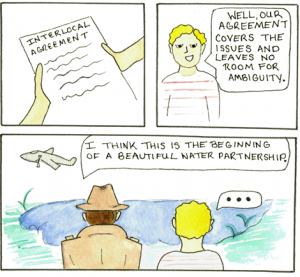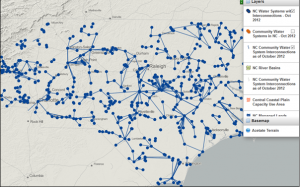
By Caroline Simpson
Caroline Simpson is a graduate student with the UNC School of Information and Library Science and works as a Research Assistant with the Environmental Finance Center.
When the North Carolina Legislature instated House Bill 448, Regionalization of Public Utilities, earlier this year, it stirred the conversation about water partnerships and their role in North Carolina. The buzz prompted discussion of partnerships ranging from mandated regionalization to voluntary interlocal agreements. At the moment, there is even a research bill in the state senate that would create a Legislative Study Commission on water quality cost share with a focus on the benefits and costs of addressing water quality issues in relation to both upstream and downstream local governments.
Some jurisdictions may look toward partnerships as a creative or cost effective strategy. Those interested in collaborative approaches have a lot to consider. Multi-jurisdictional water partnerships can take many forms in North Carolina (regional utilities, inter-local agreements, sewer and water authorities, shared storm-water programs etc.) and creating successful partnerships requires research, proactive planning, and communication. The Environmental Finance Center offers resources that aid in exploring the world of water partnerships in North Carolina and also navigating their implementation.
Here’s a Sampling of Available Tools:
Interlocal agreements are commonly used to buy and sell water but have the potential for inspired uses like joint stormwater programs. This report provides an introduction to interlocal agreements and suggests considerations to address during the writing process to reduce ambiguity and tackle issues before they arise.
If you are interested in viewing NC Water systems or community water systems that are already interconnected, check out the EFC’s interactive Water System Interconnection Map.
This report examines community water system interconnections through several different lenses such as region, type of ownership, status, size and ownership type. It also examines geographic feasibility and challenges for potential interconnections.
The UNC School of Government and the Environmental Finance Center conducted a project to promote inter-local water partnerships in Surry County. Their findings can be used as a case study for jurisdictions interested in crafting their own multijurisdictional approaches.
For a full listing of training tools and information about water partnerships check out the EFC’s Water System Partnerships, Interconnections and Interlocal Agreements web page.
RELATED BLOG POSTS: Granville Stormwater Partnership http://efc.web.unc.edu/2012/11/29/new-challenges-lead-to-new-stormwater-utility-models/
What’s your experience with collaborative water partnerships? Comment below and tell us more!



2 Responses to “Tools for Multi-jurisdictional Approaches to Water Quality”
Multiple Options for Small Drinking Water System Partnerships « Environmental Finance
[…] Tools for Multi-Jurisdictional Approaches to Water Quality […]
samb
I would like to talk with you about holding a workshop in Wisconsin on these topics. Can you contact me–all info is on my website